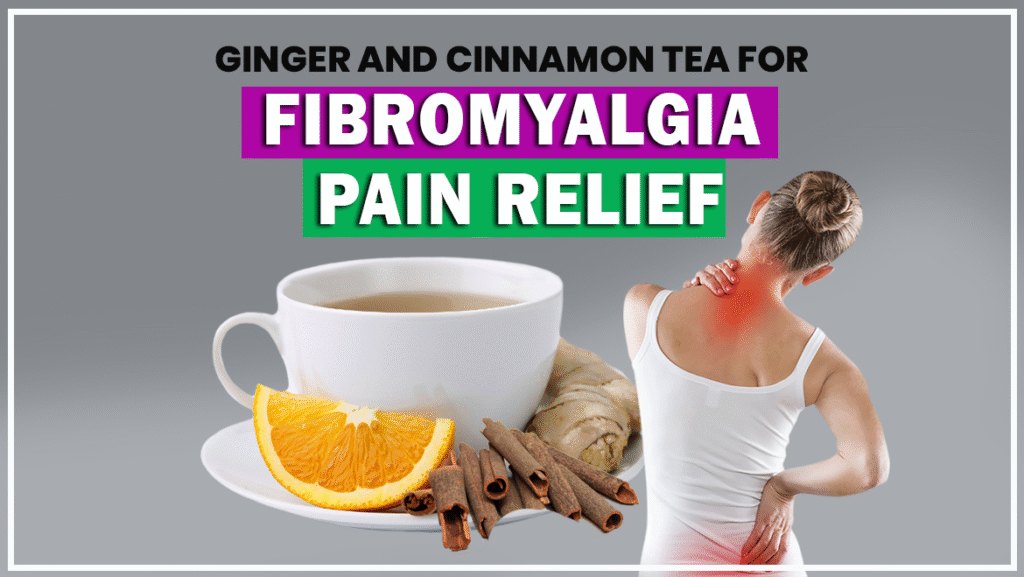Living with fibromyalgia means dealing with constant muscle pain, fatigue, and stiffness that can disrupt daily life. While medications may help manage symptoms, many people are turning to natural remedies that support the body’s healing process. One such remedy is Ginger and Cinnamon Tea, a powerful anti-inflammatory tea that offers gentle, natural relief from pain and discomfort.
Why Natural Remedies Matter for Fibromyalgia
Fibromyalgia is a complex condition characterized by chronic muscle pain, tender points, sleep issues, and brain fog. There’s no single cure, but a holistic approach — including diet, rest, and herbal support — can significantly improve quality of life.
Among natural solutions, ginger and cinnamon stand out as two of nature’s most potent anti-inflammatory and antioxidant spices.
🌿 The Healing Power of Ginger and Cinnamon
1. Ginger: The Natural Anti-Inflammatory Root
Ginger has been used for centuries in traditional medicine for joint and muscle pain relief. The secret lies in its active compounds — gingerols and shogaols — which have strong anti-inflammatory and analgesic properties.
For people with fibromyalgia, ginger tea can help:
-
Reduce muscle soreness and tenderness.
-
Improve blood circulation to ease stiffness.
-
Decrease inflammation markers that worsen chronic pain.
A 2015 study published in the Journal of Pain Research found that ginger supplementation significantly reduced muscle pain caused by exercise and inflammation — benefits that extend to chronic pain conditions like fibromyalgia.
2. Cinnamon: Nature’s Warming Spice for Pain and Energy
Cinnamon is more than just a flavorful spice. It contains powerful compounds such as cinnamaldehyde and eugenol, which act as natural muscle relaxants and anti-inflammatory agents.
Cinnamon tea can:
-
Reduce joint and muscle pain.
-
Boost metabolism and circulation.
-
Help manage blood sugar levels — important for fibromyalgia patients who experience fatigue and energy crashes.
-
Support brain function and reduce oxidative stress that may worsen fibromyalgia symptoms.
When combined, ginger and cinnamon create a therapeutic synergy — soothing the body, calming the nervous system, and supporting better energy flow.
☕ Ginger and Cinnamon Tea Recipe for Fibromyalgia Relief
Making this natural pain relief tea is simple and effective. It can be enjoyed daily, especially in the morning or evening when pain and fatigue are most noticeable.
Ingredients:
-
1 cup of water
-
1 teaspoon freshly grated ginger (or ½ teaspoon ginger powder)
-
½ teaspoon cinnamon powder (or 1 small cinnamon stick)
-
1 teaspoon honey (optional, for taste)
-
A few drops of lemon juice (optional, for added vitamin C)
Instructions:
-
Boil the water in a small pot.
-
Add ginger and cinnamon, and simmer for 7–10 minutes.
-
Strain into a cup and let it cool slightly.
-
Add honey and lemon if desired.
-
Sip slowly and enjoy the warmth spreading through your muscles and joints.
💆♀️ Health Benefits of Ginger and Cinnamon Tea for Fibromyalgia
1. Reduces Inflammation Naturally
Both ginger and cinnamon help block inflammatory pathways in the body, reducing chronic inflammation that triggers fibromyalgia pain. Gingerols and cinnamaldehyde act similarly to non-steroidal pain relievers — but without harmful side effects.
2. Eases Muscle and Joint Pain
Fibromyalgia often causes widespread muscle tenderness and stiffness. The warming nature of this tea improves circulation and reduces tension, helping muscles relax and recover naturally.
3. Boosts Energy and Reduces Fatigue
Ginger and cinnamon stimulate metabolism, helping the body burn energy more efficiently. Cinnamon also stabilizes blood sugar levels, preventing the sudden energy drops that fibromyalgia patients often face.
4. Supports Better Sleep and Relaxation
Pain and anxiety can interfere with sleep, worsening symptoms. Ginger and cinnamon have mild calming and stress-reducing effects, promoting deeper, restorative sleep.
5. Strengthens the Immune System
Both ingredients are loaded with antioxidants that protect the body from oxidative stress and support immune function — important since inflammation and fatigue can weaken defenses.
6. Aids Digestion and Gut Health
Many fibromyalgia sufferers experience digestive discomfort or IBS-like symptoms. Ginger supports healthy digestion and reduces nausea, while cinnamon promotes gut balance by fighting harmful bacteria.
🌸 Additional Tips for Using Ginger and Cinnamon Tea
-
Drink 1–2 cups daily for consistent benefits.
-
Combine with light stretching or yoga to improve mobility and relieve tension.
-
Add a pinch of black pepper to increase ginger’s absorption.
-
Choose organic, non-irradiated spices for maximum potency.
If you’re taking blood-thinning or diabetes medication, consult your doctor before making ginger and cinnamon tea part of your routine.
🌼 Lifestyle Tips to Enhance Relief
To get the most out of your fibromyalgia natural remedies, pair this tea with other holistic practices:
-
Gentle exercise (like walking, yoga, or swimming)
-
Adequate sleep and stress reduction techniques
-
Anti-inflammatory diet rich in fruits, vegetables, and omega-3 fats
-
Magnesium-rich foods to support muscle relaxation
Together, these steps create a foundation for better long-term management of fibromyalgia symptoms.
💖 Final Thoughts
Ginger and Cinnamon Tea is a simple, affordable, and effective natural remedy for fibromyalgia pain. Its powerful combination of anti-inflammatory, antioxidant, and warming properties can ease pain, soothe the body, and bring back a sense of calm and vitality.
While it’s not a cure, making this herbal tea part of your daily wellness routine can help you regain control over your health and improve your quality of life — one cup at a time.
📚 References
-
Black, C. D., & O’Connor, P. J. (2010). Acute effects of dietary ginger on muscle pain induced by eccentric exercise. The Journal of Pain, 11(9), 894–903.
👉 https://doi.org/10.1016/j.jpain.2009.12.013 -
Rahman, M. S., et al. (2014). Cinnamon: A multifaceted medicinal plant. Evidence-Based Complementary and Alternative Medicine, 2014, 1–12.
👉 https://doi.org/10.1155/2014/642942 -
Daily, J. W., Zhang, X., & Kim, D. S. (2015). Efficacy of ginger for alleviating the symptoms of primary dysmenorrhea: A systematic review and meta-analysis. Pain Medicine, 16(12), 2243–2255.
👉 https://doi.org/10.1111/pme.12853 -
National Center for Complementary and Integrative Health (NCCIH). (2023). Ginger and its health uses.
👉 https://www.nccih.nih.gov/health/ginger -
Healthline. (2023). Cinnamon Tea: Benefits, Nutrition, and How to Make It.
👉 https://www.healthline.com/nutrition/cinnamon-tea




